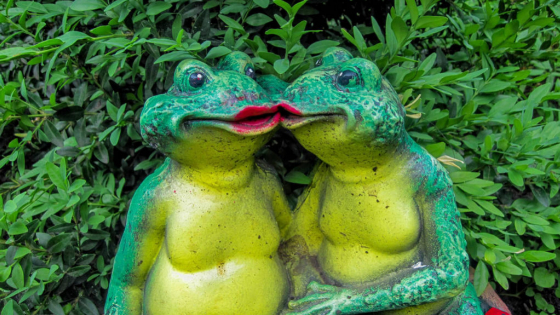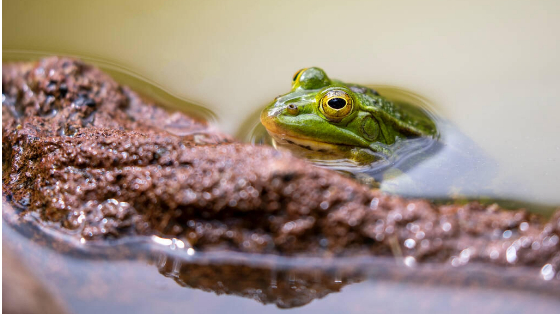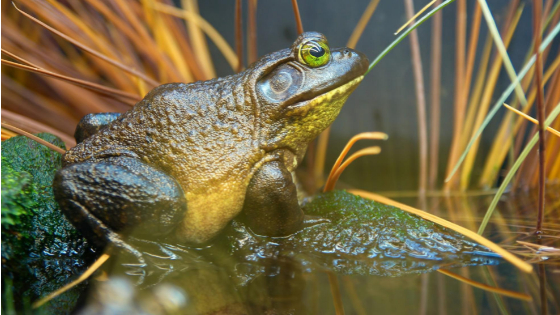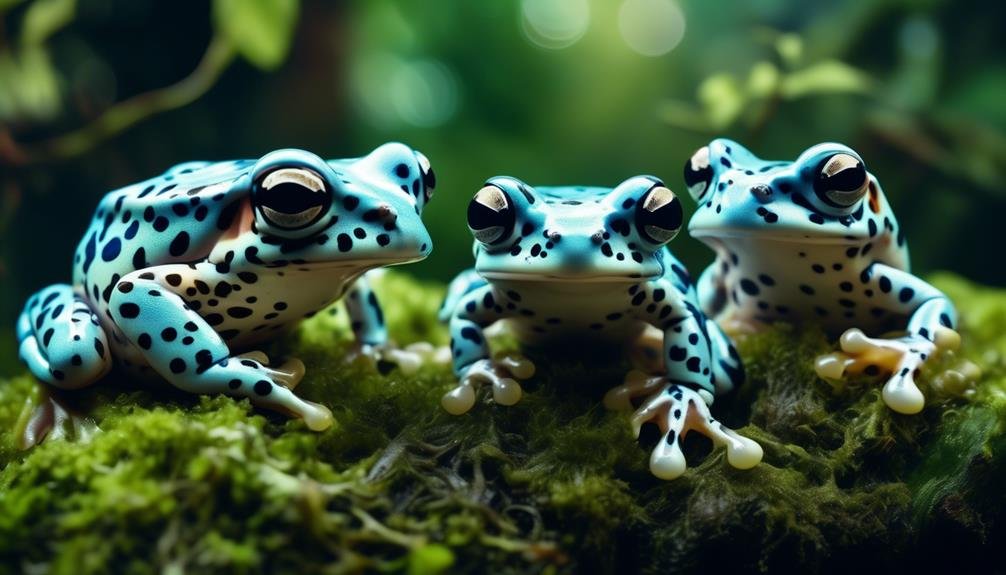
Welcome to the intriguing world of Amazon Milk Frogs, commonly known as mission golden-eyed tree frogs. These captivating creatures possess a myriad of captivating attributes and behaviors that make them truly extraordinary. From their unique physical traits to their preferred habitats and social interactions, there is a wealth of knowledge waiting to be uncovered about these enchanting tree dwellers.
As we embark on this exploration, we will uncover the secrets behind their physical adaptations, their habitat requirements, and the threats they face in their fragile ecosystem. Get ready to be enthralled by the astonishing social dynamics and intricate reproductive strategies of these nocturnal amphibians.
But that’s not all, we will also shed light on the ongoing efforts to make this information accessible to a diverse audience. Join us on this fascinating journey as we unravel the wonders of Amazon Milk Frogs, nature’s very own poisonous tree dancers.
Key Takeaways
- Milk frogs, also known as mission golden-eyed tree frogs, emit a poisonous milky secretion when threatened.
- They have bumpy skin, large toe pads, and are patterned in shades of brownish-grey.
- Milk frogs are primarily arboreal and inhabit the tropical rainforest canopy in the Amazon Basin.
- During the rainy season, they lay a clutch of 2000+ gelatinous eggs inside a tree cavity.
Fascinating Facts About Amazon Milk Frogs
Amazon milk frogs, also known as mission golden-eyed tree frogs, are fascinating creatures with unique characteristics and behaviors.
One of the most intriguing facts about these frogs is that they emit a poisonous milky secretion when threatened. This secretion acts as a defense mechanism against predators, making the milk frogs less appealing as prey.
In addition to their defensive abilities, milk frogs have distinctive physical features. They have bumpy skin and large toe pads that enable them to climb trees with ease. Their coloration consists of darker and lighter shades of brownish-grey, providing excellent camouflage within their natural habitat.
Females grow up to 3 ½ inches in length, while males reach a length of about 3 inches. These frogs also possess large vocal sacs, allowing them to produce a loud call.
Physical Characteristics of Amazon Milk Frogs
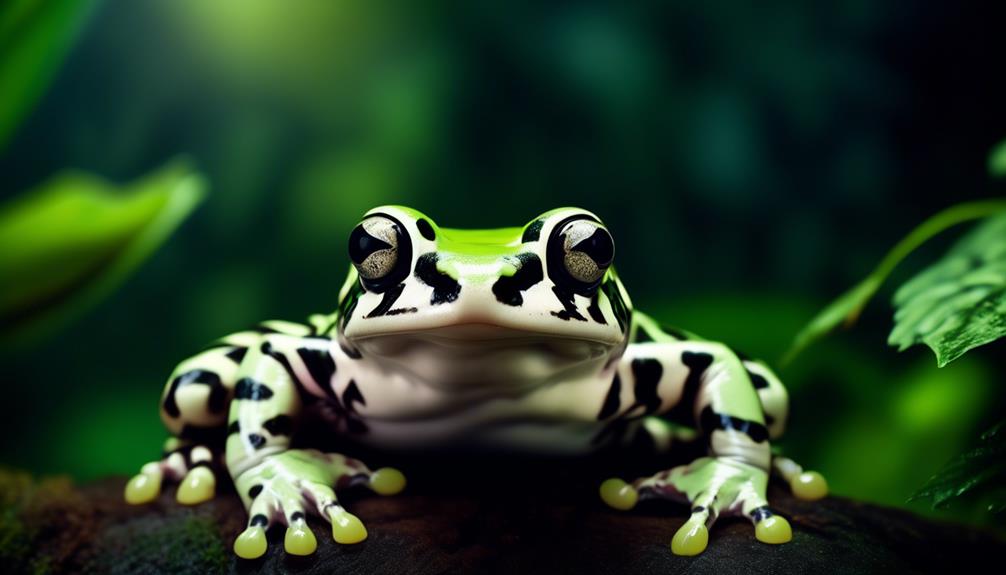
After exploring the fascinating defensive abilities and unique physical features of Amazon milk frogs, it is essential to delve into their distinct physical characteristics.
Milk frogs possess bumpy skin and large toe pads, enabling them to climb trees with ease. They exhibit patterns in darker and lighter shades of brownish-grey, providing them with natural camouflage in their rainforest habitat.
In terms of size, females can reach up to 3 ½ inches in length, while males typically grow up to 3 inches in length. Additionally, their scientific name, Trachycephalus, refers to their rounded snout, distinguishing them from other frog species.
Furthermore, milk frogs possess large vocal sacs and are capable of producing a loud call, serving as an important means of communication in their social interactions.
Habitat and Diet of Amazon Milk Frogs
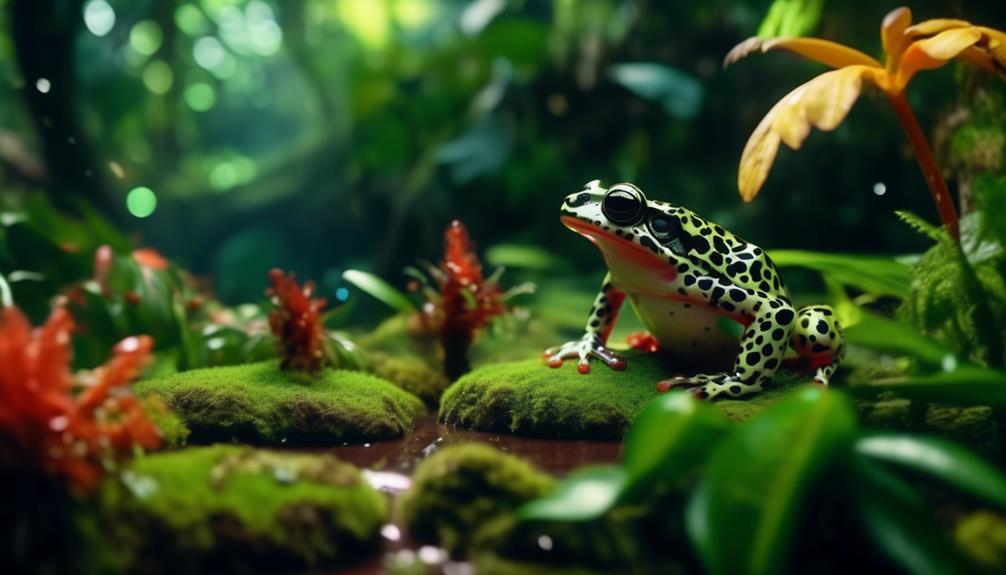
The habitat and diet of Amazon milk frogs are closely intertwined with their arboreal lifestyle in the tropical rainforest canopy. These fascinating amphibians have adapted to their environment in several ways:
- Canopy Dwellers: Amazon milk frogs spend most of their time high up in the trees, clinging to branches and leaves. They rely on their large toe pads and bumpy skin to grip onto surfaces, allowing them to navigate the complex network of branches effortlessly.
- Rainforest Canopy: Their primary habitat is the tropical rainforest canopy, found in parts of Ecuador, Venezuela, Colombia, Peru, Bolivia, Guyana, French Guiana, Suriname, and Brazil. Here, they have access to abundant food sources and a safe haven from predators.
- Varied Diet: Amazon milk frogs are opportunistic feeders, consuming a variety of small invertebrates such as insects, spiders, and worms. They use their long, sticky tongues to catch their prey, showcasing their remarkable hunting skills.
These adaptations enable Amazon milk frogs to thrive in their unique rainforest habitat and maintain a balanced diet essential for their survival.
Social Behavior and Reproduction of Amazon Milk Frogs
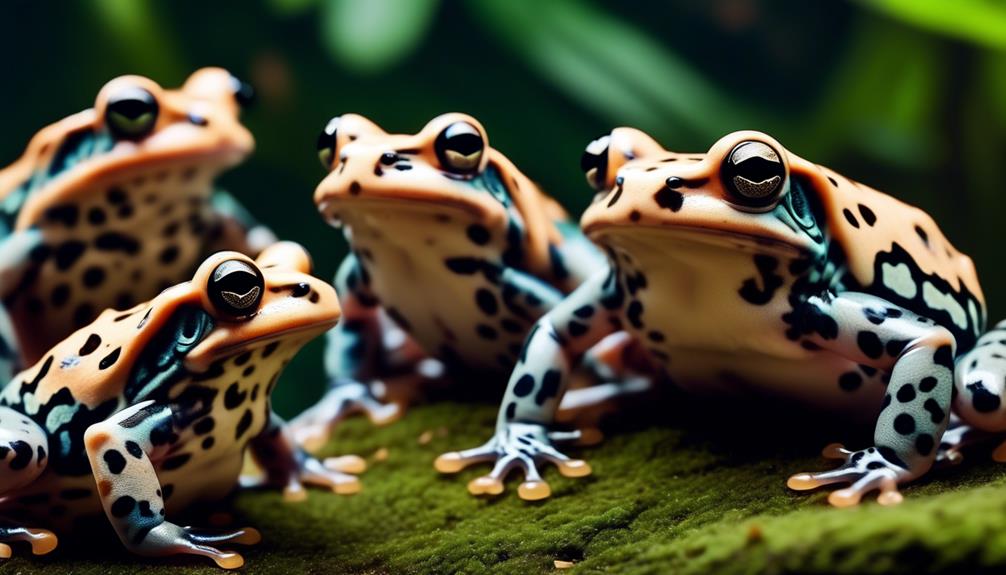
In their natural habitat of the tropical rainforest canopy, Amazon milk frogs exhibit fascinating social behavior and unique reproductive strategies. Males of this species vocalize from water-filled tree cavities on clear nights to carry the sound of their call. This vocalization serves as a means of communication and attracting potential mates. During the rainy season, females lay a clutch of 2000+ gelatinous eggs inside a tree cavity. The tadpoles hatch within a day and develop in the water-filled cavity until they are ready to undergo metamorphosis. Amazon milk frogs are nocturnal, which means they are most active during the night. This behavior allows them to avoid predators and increase their chances of survival. The table below summarizes the social behavior and reproduction of Amazon milk frogs:
| Social Behavior | Reproduction |
|---|---|
| Males vocalize to attract mates | Females lay eggs in tree cavities |
| Vocalization serves as communication | Eggs hatch into tadpoles |
| Nocturnal behavior | Tadpoles develop in water-filled cavities |
Threats to Amazon Milk Frogs
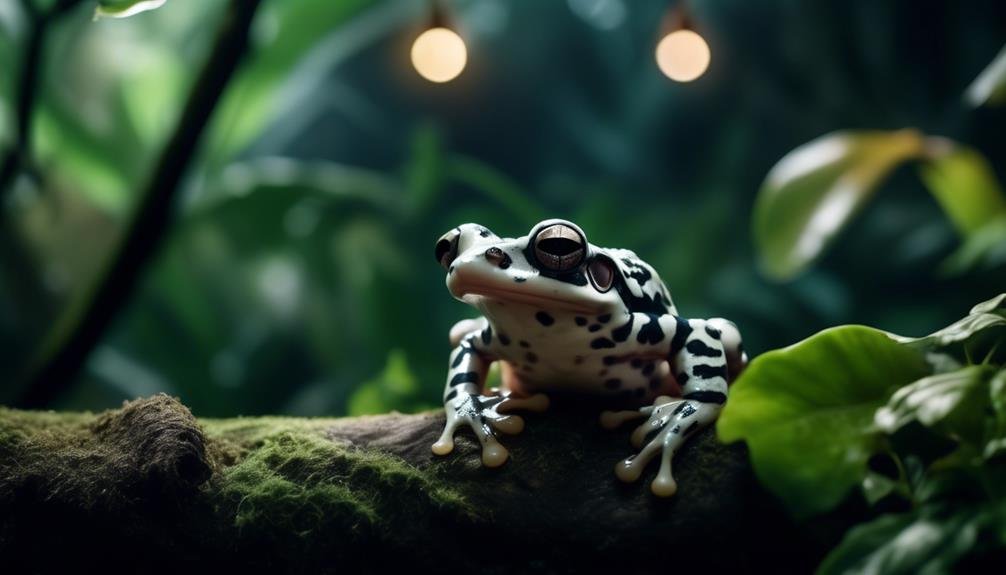
Threats loom over the Amazon milk frogs, endangering their survival in the tropical rainforest canopy. The following list highlights the dangers faced by these unique amphibians:
- Deforestation: The clearing of vast areas of the rainforest for agriculture, logging, and urbanization fragments their habitat, leaving them vulnerable to predation and limiting their access to food and breeding sites.
- Pollution: The pollution of water bodies, primarily from agricultural runoff and industrial waste, has a detrimental impact on the frogs’ health and reproductive success. It contaminates their water sources and affects their ability to find suitable mates.
- Climate change: The rising temperatures and unpredictable weather patterns associated with climate change disrupt the delicate balance of the rainforest ecosystem. This can lead to changes in the availability of food and water, making it challenging for the milk frogs to survive and reproduce.
These threats emphasize the urgent need for conservation efforts to protect the Amazon milk frogs and preserve their unique role in the rainforest ecosystem.
Accessibility Features for Website Users
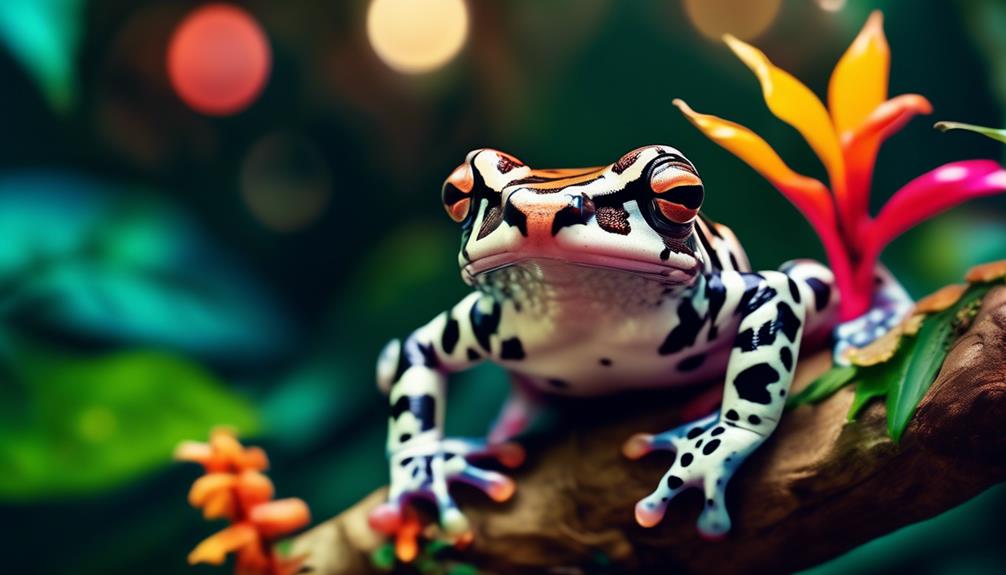
To enhance user experience and ensure inclusivity, the website offers a range of accessibility features for all users, including those with visual impairments, cognitive disabilities, epilepsy, ADHD, and other neurodevelopmental disorders. These features aim to make the website more accessible and user-friendly.
The website provides an Epilepsy Safe Mode that dampens colors and removes blinks to prevent seizures in people with epilepsy. Additionally, there is a Visually Impaired Mode that improves website visuals for users with visual impairments, and a Cognitive Disability Mode that helps users with cognitive impairments focus on specific content. The website also offers an ADHD Friendly Mode that reduces distractions and improves focus for users with ADHD and neurodevelopmental disorders.
Other features include Blindness Mode for screen-reader accessibility, UI and design adjustments, browser and assistive technology compatibility, and continuous improvements to make the website accessible to everyone.
Frequently Asked Questions
How Do Amazon Milk Frogs Use Their Vocal Sacs to Produce a Loud Call?
Amazon milk frogs use their vocal sacs to produce a loud call by inflating them with air. This amplifies the sound they create, allowing their call to carry through the rainforest canopy and attract potential mates.
What Is the Significance of the Name “Mission Golden-Eyed Tree Frogs” for Amazon Milk Frogs?
The name “mission golden-eyed tree frogs” for Amazon milk frogs holds significance as it reflects their eye color and arboreal nature. This name helps identify and differentiate them from other frog species in their habitat.
How Do Amazon Milk Frogs Protect Themselves With Their Poisonous Milky Secretion?
Amazon milk frogs protect themselves by emitting a poisonous milky secretion when threatened. This secretion acts as a deterrent to potential predators, as it can cause irritation or even toxicity if ingested or if it comes into contact with sensitive areas.
What Are the Specific Regions in the Amazon Basin Where Amazon Milk Frogs Can Be Found?
The specific regions in the Amazon Basin where Amazon Milk Frogs can be found include parts of Ecuador, Venezuela, Colombia, Peru, Bolivia, Guyana, French Guiana, Suriname, and Brazil. These frogs primarily inhabit the tropical rainforest canopy.
How Do Amazon Milk Frogs Find and Choose Tree Cavities to Lay Their Eggs In?
Amazon milk frogs find and choose tree cavities to lay their eggs in by using their keen sense of hearing. Males vocalize from water-filled tree cavities on clear nights, attracting females to deposit their gelatinous eggs inside.
Are Amazon Milk Frogs and Red-Eyed Tree Frogs Related in Any Way?
Amazon Milk Frogs and Red-Eyed Tree Frogs both hail from the rainforest canopy but are not closely related. While the milk frog secretes a protective substance, the redeyed tree frog threatened by habitat loss, relies on its iconic peepers for defense, startling predators with a flash of color.
Conclusion
In conclusion, the Amazon Milk Frogs, with their unique physical characteristics, habitat preferences, and social behaviors, are truly remarkable creatures.
From their bumpy skin and large toe pads to their distinct color patterns, these tree dwellers are captivating.
However, they face significant threats due to deforestation and pollution.
It is crucial that efforts continue to protect their habitat and ensure their survival in the face of these challenges.

